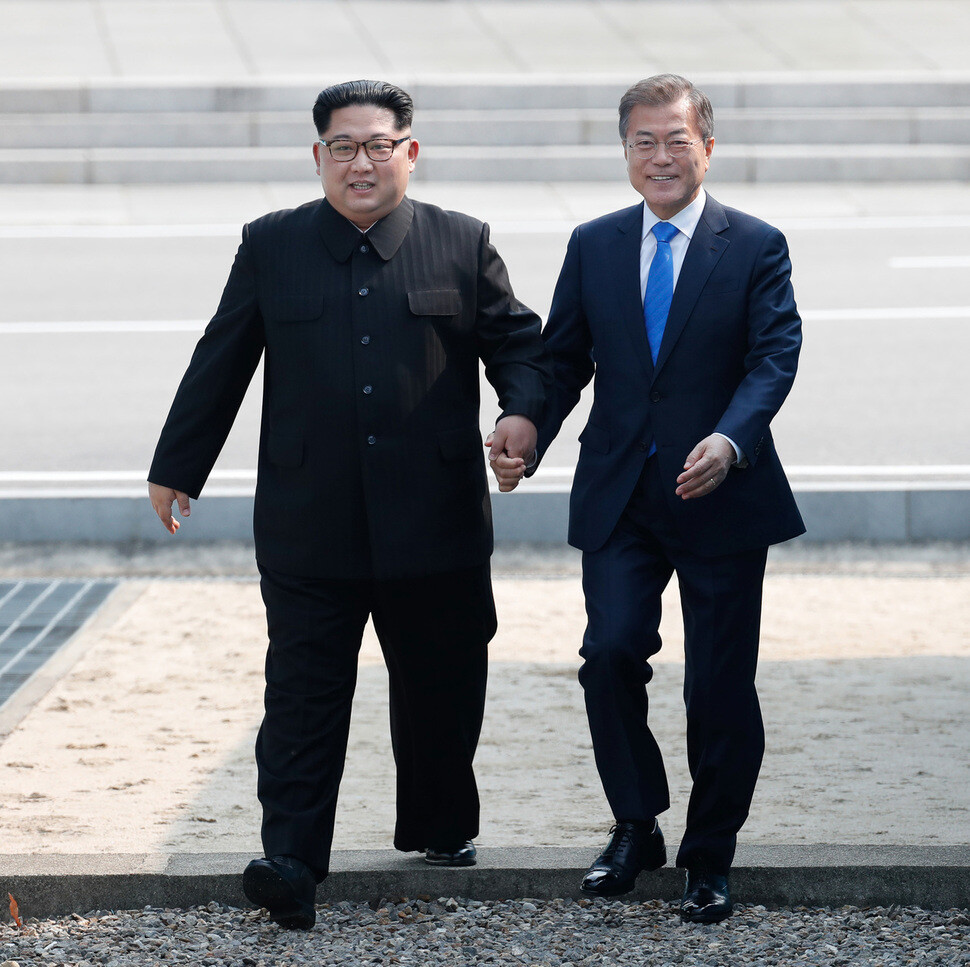hankyoreh
Links to other country sites 다른 나라 사이트 링크
S. Korean government lays out plan for inter-Korean “coexistence” and “shared prosperity”

The South Korean government has named “peaceful coexistence” and “shared prosperity” as the two chief visions of its plan for advancing inter-Korean relations through 2022. Reunification was postponed into a long-term goal. With “advancement in both inter-Korean relations and the North Korean nuclear issue” listed as one of four strategies, the administration also drew a clear line from the strategy approach requiring denuclearization ahead of advancements in inter-Korean relations.
On Dec. 3, the Ministry of Unification announced its “3rd Inter-Korean Relations Development Framework Plan (2018–2022) and 2018 Implementation Plan,” which includes two chief visions, three goals, four strategies, and five principles.
“Through the formulation and implementation of the 3rd Inter-Korean Relations Development Framework Plan, we will be concretely executing the vision and goals of Moon Jae-in’s Korean Peninsula policy,” the ministry said. According to the Constitution and the Development of Inter-Korean Relations Act, the South Korean government has been legally obligated since 2008 to develop framework plans for advancing inter-Korean relations every five years.
The third plan is structured around the terms of the Apr. 27 Panmunjom Declaration and the Pyongyang Joint Declaration and inter-Korean military agreement from September. The overarching framework involves two “visions” of peaceful coexistence and shared prosperity. Whereas the official title of the Panmunjom Declaration (“Panmunjom Declaration for Peace, Prosperity and Unification of the Korean Peninsula”) refers to “unification,” the visions do not. The omission stands in contrast with previous references to unification in the first framework plan (2008–2012), which included a vision for “shared prosperity for South and North and peaceful unification of the Korean Peninsula,” and the second (2013–2017), which included a vision for “establishing peace on the Korean Peninsula and building a base for unification.” This suggests that unification has been postponed into a long-term task expected to take more than five years.
Parallel advancement in inter-Korean relations and denuclearization
One clear difference from the first and second plans, which were developed under the Lee Myung-bak and Park Geun-hye administrations, is the explicit inclusion of “advancement in both inter-Korean relations and the North Korean nuclear issue” as one of the four major strategies. The inclusion reads as a policy commitment not to abandon progress in inter-Korean relations even if Pyongyang and Washington remain in conflict over denuclearization and normalization of relations.
The parallel advancement strategy has vied with calls for prior denuclearization as a central element in administrations’ North Korea policy since the nuclear issue first emerged in the early 1990s: the Kim Dae-jung and Roh Moo-hyun administrations advocated the parallel approach, while the administrations of Kim Young-sam, Lee, and Park advocated a strategy demanding prior denuclearization.
Another strategy included by the Moon administration was a “step-by-step, comprehensive approach” to resolving the North Korean nuclear issue. The approach, which seeks to resolve the nuclear issue within the context of a general peace process, stands in clear contrast with the strategy calling for a “package deal” and was not included in either the first or second framework plan.
The three major goals listed by the administration in its third framework plan were “resolution of the North Korean nuclear issue and establishment of permanent peace,” “sustainable advancement of inter-Korean relations,” and “achieving a new economic community on the Korean Peninsula.” The four strategies consisted of a “step-by-step, comprehensive approach,” “parallel advancement in both inter-Korean relations and the North Korean nuclear issue,” “establishing sustainability through institutionalization,” and “building a base for peaceful unification through mutual cooperation.”
The five principles consisted of “South Korean leadership in resolving Korean Peninsula issues,” “maintaining peace through strong security,” “advancing inter-Korean relations based in mutual respect,” “valuing communication with the public and consensus,” and “pursuing policies in cooperation with the international community.”
By Lee Je-hun, senior staff writer
Please direct comments or questions to [english@hani.co.kr]

Editorial・opinion
![[Column] Season 2 of special prosecutor probe may be coming to Korea soon [Column] Season 2 of special prosecutor probe may be coming to Korea soon](https://flexible.img.hani.co.kr/flexible/normal/500/300/imgdb/original/2024/0426/3317141030699447.jpg) [Column] Season 2 of special prosecutor probe may be coming to Korea soon
[Column] Season 2 of special prosecutor probe may be coming to Korea soon![[Column] Park Geun-hye déjà vu in Yoon Suk-yeol [Column] Park Geun-hye déjà vu in Yoon Suk-yeol](https://flexible.img.hani.co.kr/flexible/normal/500/300/imgdb/original/2024/0424/651713945113788.jpg) [Column] Park Geun-hye déjà vu in Yoon Suk-yeol
[Column] Park Geun-hye déjà vu in Yoon Suk-yeol- [Editorial] New weight of N. Korea’s nuclear threats makes dialogue all the more urgent
- [Guest essay] The real reason Korea’s new right wants to dub Rhee a founding father
- [Column] ‘Choson’: Is it time we start referring to N. Korea in its own terms?
- [Editorial] Japan’s rewriting of history with Korea has gone too far
- [Column] The president’s questionable capacity for dialogue
- [Column] Are chaebol firms just pizza pies for families to divvy up as they please?
- [Column] Has Korea, too, crossed the Rubicon on China?
- [Correspondent’s column] In Japan’s alliance with US, echoes of its past alliances with UK
Most viewed articles
- 1‘We must say no’: Seoul defense chief on Korean, USFK involvement in hypothetical Taiwan crisis
- 2N. Korean delegation’s trip to Iran shows how Pyongyang is leveraging ties with Moscow
- 3[Column] Season 2 of special prosecutor probe may be coming to Korea soon
- 4‘Weddingflation’ breaks the bank for Korean couples-to-be
- 5[Column] Has Korea, too, crossed the Rubicon on China?
- 6[Editorial] New weight of N. Korea’s nuclear threats makes dialogue all the more urgent
- 7[Reportage] On US campuses, student risk arrest as they call for divestment from Israel
- 8Korea sees more deaths than births for 52nd consecutive month in February
- 9[Column] Park Geun-hye déjà vu in Yoon Suk-yeol
- 10[Guest essay] The real reason Korea’s new right wants to dub Rhee a founding father